John Robb is no stranger to making money online. He’s been obsessed with it for a while.
Four years ago he started selling his own small software applications after teaching himself to code. Following that, he was an early investor in cryptocurrency and watched as the value skyrocketed to dizzying heights in early 2018. He’s earned coin as an influencer, selling shoutouts to his followers across Instagram, and racked up almost 10 million views on his YouTube channel.
Then in 2016 as a freshman in high school, he started his first ecommerce store, selling clothes for teenage girls. In the first month, he generated $50,000 in revenue. At last count, his store has made over six-figures.
Oh, and there’s one more thing.
John is only 17.



Starting an Online Business As a Teenager
By my calculations, John was just twelve years old when he first got into online business. Even at twelve, he brushed aside the idea that he was “too young” to start his own business. Instead, he charged ahead, using his enthusiasm and energy to help him learn quickly, fail fast, and rapidly build on his successes from one business to the next.
Fast-forward to December 2016, and he’s 15 years old. Like any other teenager, he spends much of his life on the internet. Mostly on memes.
→ Click Here to Launch Your Online Business with Shopify
Over the past six months, he’d been creating and posting content to a collection of comedy meme accounts on Instagram. He’d built up the accounts to large followings and had started to attract attention from brands. “I was getting to the point where businesses were direct messaging and emailing me getting me to promote a product for them,” he says.
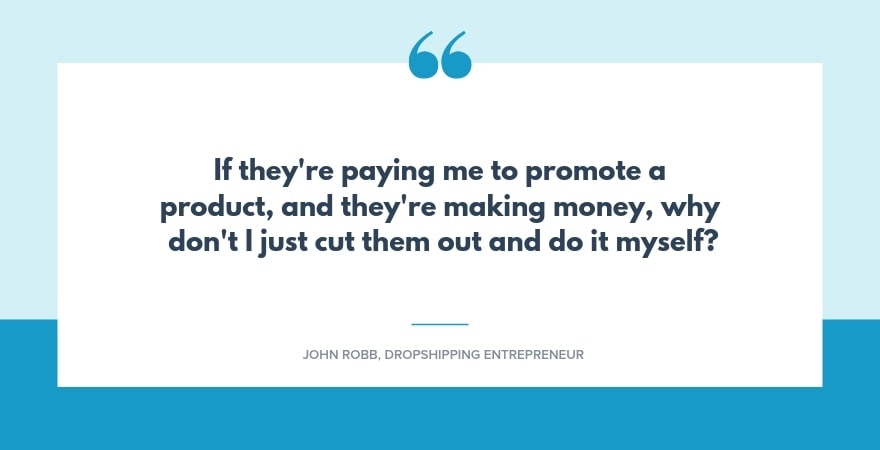
But as he began to take on more of those deals, he noticed that many of the products the different brands were asking him to promote looked familiar. “I realized was that a lot of these stores have the exact same products, so I wanted to figure out what was going on. That’s when I figured out that they were dropshipping.”
Psst… haven’t heard of dropshipping yet? Come closer, I’ll explain.
Dropshipping is a business model that allows entrepreneurs to set up an ecommerce business without having to invest in inventory. Entrepreneurs find products they want to sell from suppliers across the world through AliExpress, then pull the inventory information through to their store using an AliExpress import app. The cool thing is that the store owner doesn’t have to deal with warehousing or fulfillment, because their supplier holds all of their stock. Once a customer buys an item from their store, they pay the money to their supplier, and the supplier ships the product directly to their customer. Plus, because they’re not paying upfront for a bunch of stock, the store owner can change the products in their store quickly and easily. If something isn’t selling, they can swap it out and try something new.
Okay, and back to our regularly scheduled programming.
So after John heard about dropshipping, he had a revelation.
“I was like, ‘If they’re paying me to promote a product, and they’re making money, why don’t I just cut them out and do it myself?’”
So that’s what he did.

Finding Products To Sell
John got to work quickly. He created an online store with Shopify and signed up for DSers to help him find and fulfill products.
Then he made his only upfront investment into the business and paid $8 for a domain name.
He started browsing for products he thought would appeal to his teenage girl audience. “I had a decent pulse on fashion because I’m around teenage girls a lot at school, right?” he says.
He found a few pieces of clothing that mirrored the stuff he saw girls his age at school wearing: clothes in baby pink and other pastel colors, with edgy slogans and plenty of Drake references.
Then, he found the shorts.
They were cute shorts. High-waisted, with bright metallic colors, and flattering to pretty much anyone who wore them. John sensed a winner and added them to his store immediately.
But it wasn’t enough to go on his gut instinct, he had to test them to see if they would work. So he created a meme-style image of the shorts and posted it to his meme accounts.
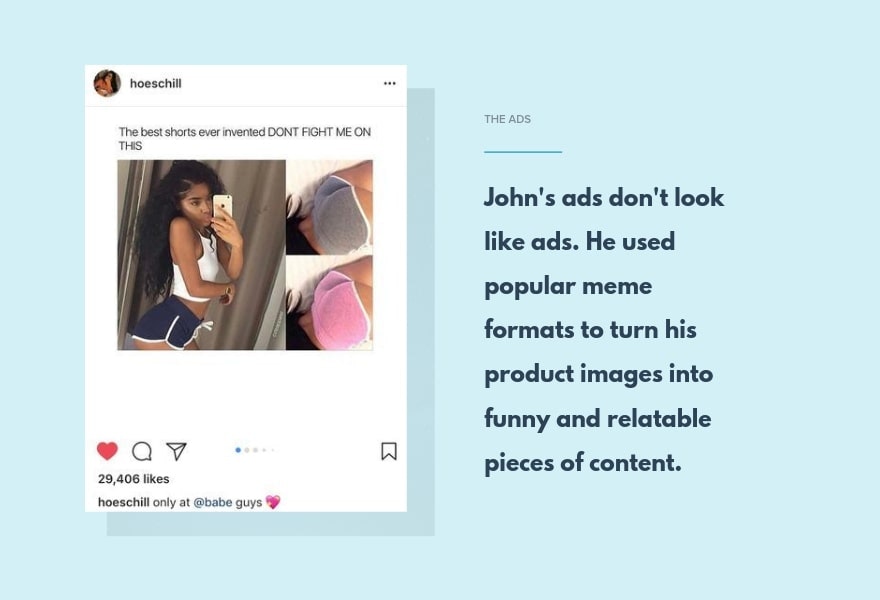
The response was quick. Within the first couple of hours, he’d already made $50 in sales.
“So then I thought, ‘I’m going to reinvest this and buy an ad from a bigger meme page.’ I bought an ad from a page that had a couple million followers, and that returned $700 in sales, just that day.”
From his initial $8 investment, he’d generated $700 in sales on the first day.
From there, things went up and up. “I just kept scaling it. I just kept spending money on ads, and it went crazy,” he says.
His instincts were right, the shorts were a hit. John watched as 90 percent of his sales that poured in were for that single product.
Even though he went in with high hopes, John admits that the reality exceeded his lofty expectations.
“I was pretty ambitious about it, and I was pretty confident that I was going to succeed with it,” he says. “I launched it the day that winter break from school started, and my goal was to make $5,000 over the break. I ended up making $50,000. At its peak, the store was making $3,500 a day.
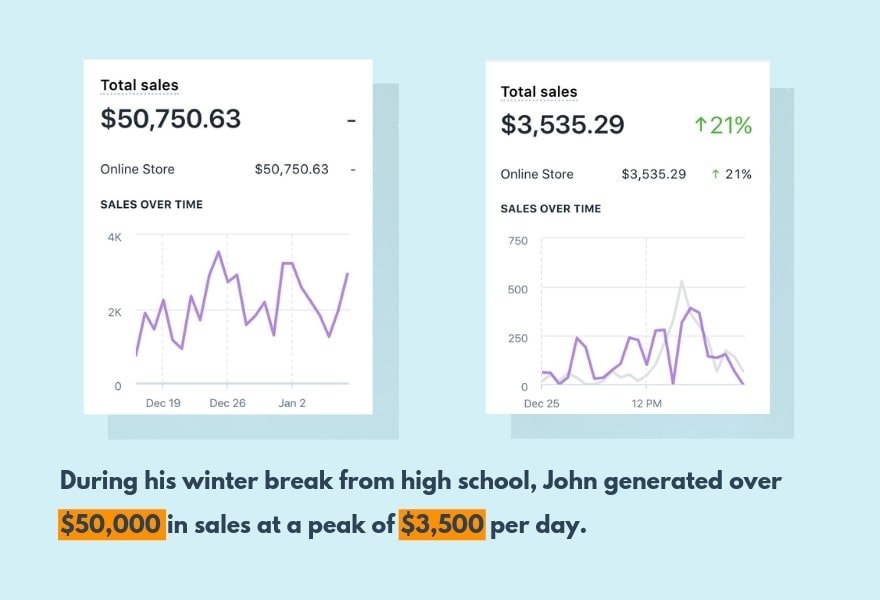
How Can You Make Money With Memes?
As John scaled his business, he began working with larger and larger influencers on Instagram.
But unlike most fashion brands, he knew that it wasn’t just fashion influencers that would be able to help him promote his products. “All my ads were posted on meme or relatable accounts on Instagram, which I think works better than fashion influencers,” he says. “The prices for getting a post on a fashion page are so inflated. Everyone thinks that if they want to sell clothes, they have to go to a fashion page. What you don’t realize is that everyone wears clothes, you can go to just about any page.”
Plus, sticking to meme accounts meant that John also held strong to his golden rule: “Don’t be cliche and try so hard when it comes to marketing.”
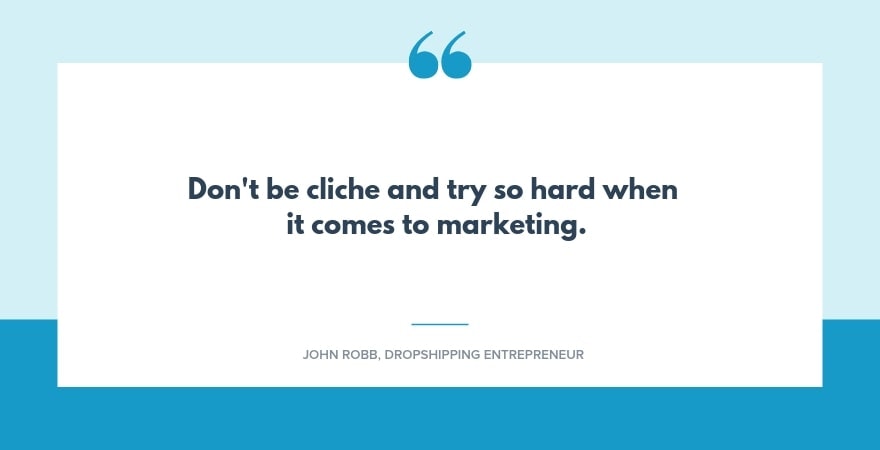
“If your ad looks like an ad, people are going to swipe by it and not like it or engage with it,” he says. “So my strategy was, don’t be intrusive and annoying. Fit it into the influencer’s feed. Make it a cute little meme or a joke.”
When creating content to post on other influencer’s accounts, John followed a popular meme format create ads that were eye-catching enough to stop the endless scroll.
“A lot of memes are in Twitter format. So mine would have an image of someone wearing the product and above it would say something like, ‘My boyfriend bought me these 😍😍.’ Then I directed them in the caption to click on the link in my brand’s Instagram bio, so I was able to pick up followers and remarket to them even if they didn’t purchase on the spot.”
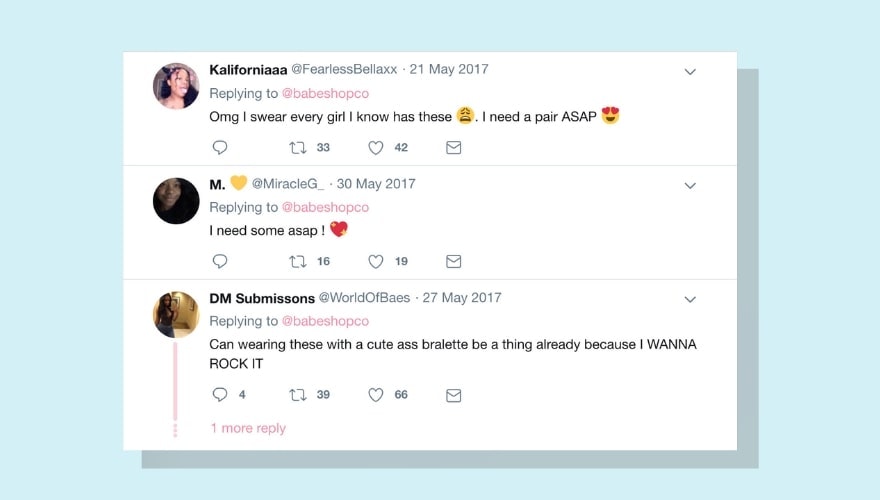
Optimizing and Scaling Your Business
While he was running the business, John dedicated much of his time to finding new influencers to help promote his products and reaching out to them. He also got into the nitty-gritty of conversion optimization, and spent a bunch of time optimizing his site.
“A lot of my time was spent figuring out how to use upsell applications, or just making small adjustments to increase my conversion rate. I’d try things like changing the add to cart button color or tweaking the checkout process,” he says.
He taught himself email marketing and customer retention strategies, spending late nights pouring over ecommerce blogs or YouTube tutorials. “There are so many resources online. You can learn just on YouTube or through Googling stuff, it’s ridiculous,” he says.
In classic entrepreneur behavior, his mind was always buzzing with the next business idea. John was impressed by the power of influencer marketing and wanted to take advantage of the experience he’d built with influencer outreach and marketing strategies.
So more recently, he’s been spending his time working on Influencer Hive, a new platform that allows brands to connect with influencers who can promote their products. Through this, he’s been able to use his experience to help give other ecommerce entrepreneurs a leg-up and gain exposure for their stores.
“I started to get to a point where I wanted to do something new,” he says. “I had learned a lot with the store, and I had made a lot of money. I wanted to do something related to what I learned, so that’s what I’m doing now.”
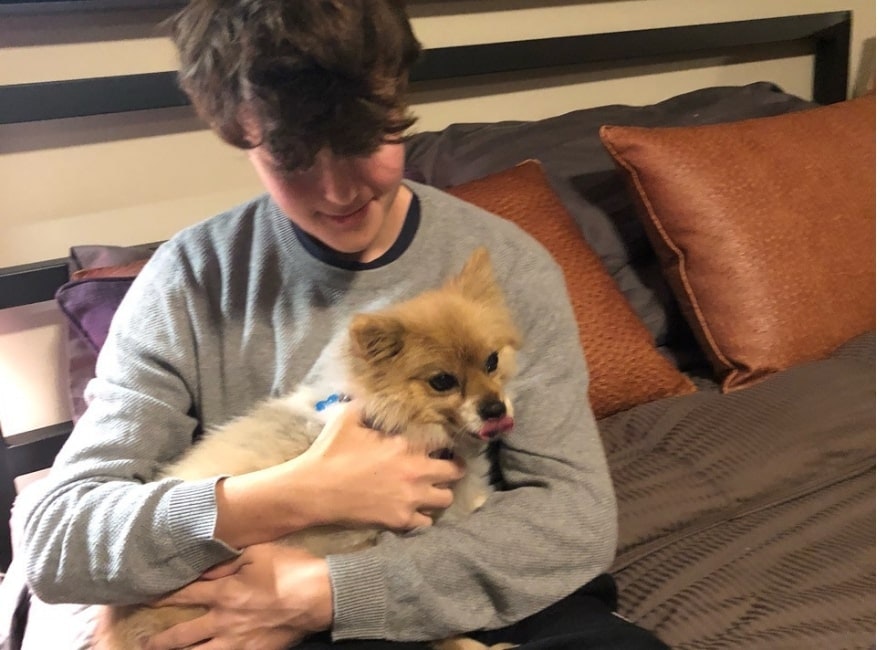
What’s Next For John?
So in the end, at just 15 years old, John was the owner of an ecommerce store that generated over to six-figures in sales in its first year.
It’s an achievement that in some ways, isn’t so surprising. When you’re the kind of kid who starts selling your own software applications at age twelve, it’s pretty clear you’ve got a life of interesting entrepreneurial pursuits ahead of you.
He pauses for a moment to reflect on the impact that choosing to start this store has had on his life.
“I feel like it was the final thing that made me realize that I wasn’t going to be doing normal, crappy jobs where I work for other people,” he says proudly. “It made me realize that I want just to create my own path and build my own things. It made me a more creative and confident person in business.”
And with this newfound confidence, he’s found a whole new world of opportunity opening up in front of him.
“I realized that with the internet you can do just about anything. With financial success, you’re not limited at all. No matter who you are, where you are, what you have, if you want to get something done, then you just do it.”



